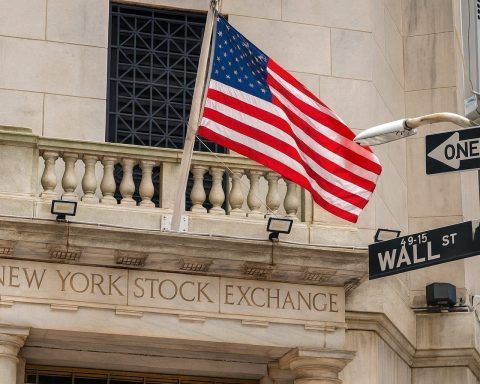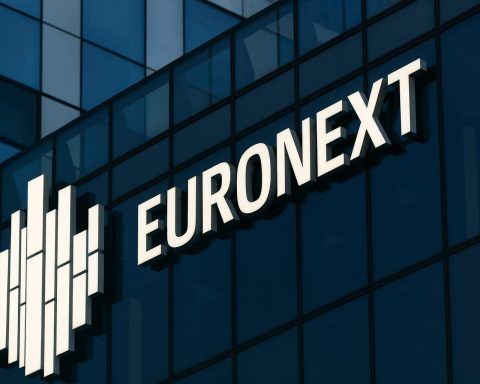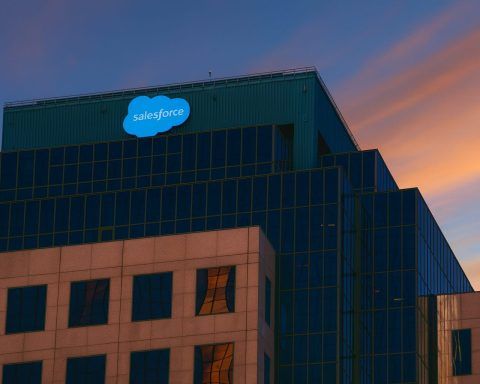- Nvidia’s AI windfall: Chip titan Nvidia smashed expectations and guided for record sales next quarter ($54 billion vs. $53.1 billion expected) [1], thanks to insatiable demand for its AI processors. CEO Jensen Huang declared “a new industrial revolution has started… AI race is on” and sees $3–4 trillion in AI infrastructure spend by 2030 [2] [3]. Shares dipped ~2–3% after hours, as growth showed first hints of moderating [4] [5], but Huang dismissed bubble fears, noting “everything [is] sold out” for Nvidia’s next-gen chips [6].
- Data platforms soar on AI:Snowflake’s stock jumped ~14% after the cloud data firm hiked its revenue forecast (to $4.40 B vs $4.33 B prior) on booming enterprise AI demand [7]. MongoDB exploded ~31% as it revealed spiking usage of its Atlas database from customers building generative AI apps [8], prompting upbeat new revenue and profit guidance above estimates [9]. Analysts said both are key AI beneficiaries – Snowflake helps firms “simplify AI adoption” [10], while MongoDB’s cloud database handles the surge of unstructured data from AI workloads [11].
- Investors pile in (and pontificate): Wall Street’s AI euphoria hit fever pitch. The S&P 500 closed at a record high ahead of Nvidia’s results [12], with one portfolio manager predicting Nvidia could soon be “a double-digit percentage of the S&P 500” by itself [13]. Dozens of analysts hiked targets on the data plays – 24+ analysts boosted Snowflake’s price targets (median ~$260) [14], and 15+ did so for MongoDB [15]. Still, some preached caution: OpenAI’s Sam Altman warned investors might be “overexcited” about AI’s promise [16], and Nvidia’s mild guidance drop led to talk of the AI trade’s pace cooling if China remains a wild card [17].
- Big Tech bets on AI arms race: Major players escalated AI investments. Alphabet’s Google announced a $9 billion expansion of its Virginia data centers for AI and cloud through 2026 [18], underscoring the build-out of infrastructure for AI services. Meanwhile, an exclusive $10+ billion cloud deal emerged between Meta and Google (reported Aug 22), aligning Meta’s AI needs with Google’s cloud might [19]. And in enterprise software, Workday touted 12%+ revenue growth (Q2 FY2026) fueled partly by new AI features, raising its outlook in an earlier report [20].
- Flurry of AI M&A and funding: The gold rush in AI spurred strategic deals. CrowdStrike (cybersecurity) agreed to buy startup Onum – a specialist in real-time data pipelines – to “drive autonomous cybersecurity at scale” and “stop breaches at the speed of AI,” said CEO George Kurtz [21] [22]. The deal (reportedly ~$290 million) will fold Onum’s lightning-fast telemetry tech into CrowdStrike’s AI-driven platform. Accenture unveiled plans to acquire NeuraFlash, a Salesforce-focused gen AI consulting firm, adding 500+ experts to bolster its “agentic AI” solutions for clients and mid-market companies [23] [24]. In healthcare AI, Tempus announced a buyout of digital pathology startup Paige for $81 million (Aug 22), aiming to train AI on one of the world’s largest cancer image datasets. Venture capital continued pouring in: Databricks, an AI data platform rival, is raising funds at an eye-watering >$100 billion valuation [25], and open-source AI hub Hugging Face closed a fresh $235 million round (Aug 24) led by Salesforce and Nvidia.
- Government stakes & regulations: Governments worldwide leaned into the AI race. In a bold first, the U.S. government took a 9.9% stake in Intel (via CHIPS Act funding) to secure domestic chip supply [26] – a move praised by Trump and Sanders alike as industrial policy meets tech. Observers note Washington as a shareholder could complicate Intel’s China business [27] [28], but it underscores AI chips’ strategic importance. China, for its part, issued sweeping support: a new State Council guideline to implement the “AI Plus” initiative sparked a rally in Chinese AI stocks [29]. A Shenzhen AI ETF jumped ~2%, and several local AI developers hit the +10% daily limit on state backing for deeper AI integration across industries [30]. Beijing’s plan targets 70%+ AI penetration in key sectors soon and 90% by 2030, heralding a “smart economy” era [31] [32]. At the same time, China’s chipmakers are racing to triple domestic AI chip output by 2026 to cut reliance on Nvidia [33] – with Huawei poised to open new AI chip fabs that could rival the output of national foundry SMIC [34]. Regulators also kept a wary eye on AI’s risks: in California, OpenAI and CEO Sam Altman were sued in a precedent-setting case by parents alleging ChatGPT contributed to a teen’s suicide [35], intensifying debates over AI safety and oversight.
- Outlook: AI boom “far from over”: Despite pockets of concern, the consensus is that the AI boom still has legs. As Nvidia’s Huang put it, the world’s data centers and cloud giants are only in the “early stages” of a massive AI build-out [36] [37]. Investors are hunting for the next AI winners beyond the obvious chip and cloud plays. “The past few years rewarded the infrastructure – now it’s data providers’ turn,” noted Quilter Cheviot analyst Ben Barringer, pointing to Snowflake and others seeing AI’s “significant effect” on demand [38]. With AI revenues still soaring 50%+ at leaders like Nvidia and trillions in capex on the horizon [39] [40], bulls argue this tech super-cycle is just getting started. The coming months will test whether these lofty expectations hold, but for now AI remains the driving force of 2025’s market rally, rewriting playbooks in Silicon Valley and boardrooms worldwide.
In-Depth Report
Nvidia’s Blockbuster Earnings Test the AI Trade
AI-chip bellwether Nvidia delivered another blowout quarter, underlining the extraordinary scale of the ongoing AI boom. The company’s fiscal Q2 results (reported Aug 27) easily beat estimates, and management issued an even higher forecast for Q3 revenue — about $54 billion, plus/minus 2% [41]. That guidance edged past Wall Street’s ~$53.1 billion consensus and implies astonishing 170%+ growth year-on-year, cementing Nvidia as the de facto arms dealer of the AI era.
Behind the numbers is “robust demand” from cloud providers expanding generative AI infrastructure [42]. Hyperscalers like Microsoft, Google, Amazon and Meta – many of them Nvidia’s largest customers [43] – have been racing to deploy more AI servers, driving “humongous” orders for Nvidia’s cutting-edge GPUs. In fact, CEO Jensen Huang said hyperscalers’ capital spending on AI this year will reach ~$600 billion, and for a flagship $60 billion data center, roughly $35 billion might flow to Nvidia’s chips alone [44]. Demand is so intense that even a constrained version of Nvidia’s H100 chip (the “H20” made for China) saw $650 million in purchases last quarter by a non-Chinese customer eager to stock up [45].
Yet, Nvidia’s stock reaction was a reality check. Despite the top- and bottom-line beat, shares initially fell ~2–3% in after-hours trading [46] [47]. Why the dip? Growth, while still massive, is beginning to moderate from last year’s triple-digit percentages. Q2 revenue was up “only” 88% YoY (vs. 101% prior quarter), and core data-center sales ticked down ~1% sequentially [48] for the first time since the AI boom began – a sign that the torrid pace is normalizing. Huang’s Q3 outlook excluded any new sales to China amid U.S. export curbs [49], effectively baking in a ~$5–8 billion “China handicap” that has investors pondering how long AI demand can keep overcoming geopolitical barriers [50] [51]. “If there is not a deal with China it raises questions how future revenue expectations can be sustained… If the AI sector is in a bubble…it makes the recent S&P rally look overvalued,” cautioned 2040 Advisory’s Taufiq Rahim [52]. Nvidia’s gross margin guidance of 73.5% impressed bulls [53], but overall the slight slowdown “feels like a disappointment” to a market now accustomed to “blowout” beats [54]. As one portfolio manager noted, “Nvidia’s streak of extraordinary revenue beats is losing its shock factor” [55] – inevitable as $50+ billion quarters become the new normal.
On the company’s earnings call, Jensen Huang struck an emphatically optimistic tone to allay any jitters. Far from an AI fad fizzling out, he argued the opposite: “The AI boom is far from over”. Huang predicted *global spending on AI infrastructure will reach $3 trillion to $4 trillion by 2030 [56] [57], encompassing not just Big Tech but also sovereign governments and every industry adopting AI. “A new industrial revolution has started. The AI race is on,” Huang proclaimed [58]. He noted that Nvidia’s latest generation “Blackwell” data-center GPUs are already essentially sold out through 2026 based on major customers’ orders [59], and even the current “Hopper” chips remain on backlog as enterprises large and small scramble to procure AI capacity. In Huang’s view, “the more [compute] you buy, the more you grow” – meaning companies that invest heavily in AI see such productivity gains that it justifies further investment [60]. In other words, AI’s ROI is so compelling that demand could be self-reinforcing for years.
Many market observers share Huang’s longer-term enthusiasm. “The overall AI trade is still very much intact,” said Thomas Martin of GLOBALT Investments [61], pointing to huge multiyear cloud budgets as evidence “we’re in the early stages” of an AI build-out [62]. Matt Orton of Raymond James likewise sees “a lot of durability to this AI trade” – hyperscalers’ businesses are accelerating, and Nvidia’s results show “no sign of a slowdown” in end-demand [63]. Even after doubling year-to-date, Nvidia’s stock (NVDA) now making up over 8% of the entire S&P 500 [64], some fund managers argue it could eventually reach 10+% of the index given its outsized growth trajectory [65]. That would be virtually unprecedented dominance by a single company – reflecting how central AI has become to market fortunes.
Yet a few voices urge vigilance amid the exuberance. Notably, OpenAI CEO Sam Altman – whose ChatGPT sparked much of this boom – mused that investors might be “overexcited” about AI and underestimating the challenges ahead [66]. Altman’s comments earlier in August caused a brief chill in AI stocks, feeding the narrative that a plateau or backlash could emerge. And while Nvidia remains “the benchmark AI stock” [67], its 230%+ YTD surge has lifted valuations across the sector; the S&P 500’s forward P/E hit ~22×, a four-year high, largely on AI hype [68]. This leaves little margin for error if growth blinks. As Zacks’ analyst Brian Mulberry quipped after Nvidia’s report, “Now NVDA is ‘only’ growing at 50–55%, much less than the 100%+ last year… as momentum slows, so does energy in the stock” [69]. Indeed, Nvidia’s stock sold off ~3% the day after earnings (Aug 28) despite consensus-beating results [70], reflecting extremely high market expectations.
The bottom line: Nvidia’s earnings reaffirmed that the AI revolution is in full swing, with unprecedented revenue levels to prove it. The slight growth deceleration and China uncertainty injected a dose of realism, but for now Wall Street remains mostly in “buy the dip” mode on NVDA [71], trusting Huang’s bullish vision. As a Reuters tech columnist put it, “Nvidia’s Q3 forecasts suggest the AI trade has more to run” [72]. The coming quarters – particularly any updates on U.S.–China tech trade or cloud spending – will be critical in determining if Nvidia can keep defying gravity or if the “hyperscale” AI trade finally takes a breather.
Snowflake & MongoDB Ride the AI Wave to Soaring Stocks
While Nvidia provides the picks and shovels of the AI gold rush, a new cohort of data platform companies is emerging as big winners in the value chain. Over August 27–28, two such firms – Snowflake and MongoDB – saw their stocks skyrocket after reporting strong results turbocharged by AI adoption. Their success underscores that beyond chips and cloud, “data providers” are increasingly in the sweet spot of enterprise AI spending [73].
Snowflake Inc. – the cloud data warehousing pioneer – delighted investors on Aug 27 with an upbeat quarterly report and guidance raise. The company said demand for its platform is accelerating as organizations modernize data infrastructure for AI [74]. With more customers exploring generative AI strategies, Snowflake’s centralized data architecture is a natural choice to “host and manage AI models… in a single environment,” simplifying the otherwise complex AI tech stack [75]. Management noted a particular surge in usage on Microsoft Azure (up 40% YoY) as Snowflake benefits from Azure’s own AI growth [76]. Riding these tailwinds, Snowflake raised its product revenue forecast for FY2026 to $4.40 billion (from $4.33 B) [77], surpassing analysts’ estimates and signaling confidence in second-half bookings. CEO Sridhar Ramaswamy (a recent leadership change at Snowflake) highlighted that enterprise AI initiatives are translating into bigger Snowflake deployments, as companies require flexible, cloud-agnostic data platforms to leverage AI insights [78] [79].
Wall Street loved the story: Snowflake’s shares surged 13–14% in late trading [80], on track to add a whopping $11 billion to its market cap if gains held [81]. By Aug 28 the stock was one of the market’s top gainers. “Investors are increasingly searching for opportunities where AI is making a real difference,” observed Quilter Cheviot analyst Ben Barringer; while the Nvidias and Microsofts have rallied, he noted, “it is [now] having a significant effect among data providers” like Snowflake [82]. In other words, the investment spotlight is broadening beyond just AI chipmakers to the software and database layer that actually operationalizes AI for businesses. Janus Henderson’s Richard Clode, whose fund holds Snowflake, concurred that Snowflake is a “key beneficiary of the AI and cloud migration trend”, since its modern data architecture helps companies leverage AI innovation alongside other next-gen databases [83]. There’s validation in numbers too: Snowflake reported $6.9 billion in remaining performance obligations (RPO) – a 33% YoY jump in backlog signaling robust forward demand [84], as clients sign multi-year deals to embed Snowflake at the core of their AI analytics workflows.
Another big winner was MongoDB, the database software maker known for its NoSQL document database. On Aug 27, MongoDB’s stock exploded ~31% higher in one day [85] after it revealed that AI applications are fueling usage of its Atlas cloud database service at unprecedented levels. “Generative AI apps process vast amounts of unstructured data, driving demand for cloud databases like Atlas,” Reuters noted [86]. This trend was on full display in MongoDB’s results: the company topped revenue expectations and hiked its full-year forecasts significantly. It now projects $2.34–2.36 billion in FY revenue (up from ~$2.27 B prior) and $3.64–3.73 in adj. EPS (up from ~$3.03 prior) [87] – an unusually large guidance boost reflecting a real inflection in usage. Both the new revenue and profit outlooks trounced analyst estimates [88]. MongoDB’s CEO Dev Ittycheria said reallocating sales resources to AI-focused customers is paying off, with Atlas becoming a backbone for clients building AI-driven features like chatbots, recommendation engines, and semantic search [89] [90]. One Morningstar analyst applauded MongoDB’s “strong go-to-market momentum… thanks to product enhancements in artificial intelligence” [91]. In short, MongoDB has pivoted to embrace the AI wave, and the wave is lifting all boats.
The market reaction was dramatic: at one point MongoDB added over $5 billion in market cap in a single session [92], a strong vote of confidence. More than 15 sell-side analysts rushed to raise their price targets after the earnings, and some upgraded the stock to “Buy” [93]. Even after the pop, analysts argued MongoDB (MDB) still trades at a reasonable ~59× forward earnings – rich, but half the multiple of Snowflake (~143×) and not far from cloud peer Oracle (~33×) [94] [95]. This relative valuation, coupled with Mongo’s accelerating growth (24% YoY revenue gain, up from 18% prior quarter [96]), suggests investors see it as both an AI play and a broader database platform story that can sustain momentum.
It wasn’t just Snowflake and MongoDB enjoying an “AI halo.” Other enterprise tech names with AI angles moved as well. For example, analytics firm Datadog and AI-cloud platform C3.ai saw shares fluctuate amid the week’s AI news – though C3.ai’s own earnings were still ahead in early September, its stock had been volatile after a preliminary outlook. One notable development: privately-held Databricks, a leader in data engineering and machine learning tools, was reported to be raising a massive Series K funding at over $100 billion valuation [97] (nearly double its last valuation). This news, coming just weeks after competitor Snowflake’s market cap hovered around $70 billion, underscored the intense investor appetite for AI-native data platforms. Databricks’ round (rumored to involve Saudi Arabia’s Public Investment Fund) highlights that the private markets are chasing the AI trend as eagerly as public markets, setting the stage for future IPOs.
Together, Snowflake and MongoDB’s success indicates that “picks and shovels” software companies enabling AI workloads are reaping significant rewards. As enterprises everywhere look to inject AI into their products and operations, they need places to store and quickly retrieve the deluge of data that training and running AI entails. Cloud-based databases and data warehouses fit that bill perfectly. The fact that both companies exceeded expectations and grew more optimistic about the year ahead suggests that AI projects are moving out of pilot phase into real production usage, generating tangible revenue for the data infrastructure firms. If this trend continues, we can expect the market’s AI rally to broaden to a wider circle of software names, not just the mega-cap AI chip and cloud providers.
Deals, Investments & Expansion: Industry Races to Capitalize on AI
Beyond earnings, the past 48 hours were marked by a flurry of M&A deals, venture funding, and capacity investments in the AI sector, as companies large and small positioned themselves for the next phase of growth. From cybersecurity to consulting to Big Tech, it seems everyone is making moves to double down on AI.
In the cybersecurity realm, CrowdStrike Holdings announced on Aug 27 that it plans to acquire Onum, a 2022-founded startup specializing in real-time data pipeline management. CrowdStrike will integrate Onum into its flagship Falcon platform to eliminate data onboarding bottlenecks and enable “autonomous in-pipeline threat detection” [98] [99]. CEO George Kurtz said the goal is to stream high-quality filtered data directly into CrowdStrike’s AI-driven security cloud, helping “stop breaches at the speed of AI” [100]. While terms were not disclosed [101], Fortune [102] and Bloomberg reported the price around $290 million, making it a sizable bet on AI-enhanced security. The deal illustrates how cybersecurity providers are leveraging AI: by ingesting vast telemetry data and using machine learning to detect threats faster than humans. CrowdStrike’s stock (CRWD) has been an AI beneficiary this year (up ~40% YTD) as investors anticipate AI will revolutionize cyber defense – this Onum buy is intended to keep CrowdStrike at the cutting edge.
Meanwhile, in enterprise IT services, global consulting giant Accenture revealed an agreement to purchase NeuraFlash, a private consulting firm that specializes in Salesforce automation and generative AI solutions [103]. Announced Aug 27, the acquisition will add 510+ skilled professionals (with 2,000+ Salesforce certifications) to Accenture’s roster, enhancing its capacity to deliver AI-enabled Salesforce projects [104]. NeuraFlash has done 1,000+ implementations for clients, focusing on AI “agent” solutions in sales and customer service. Accenture said this will “significantly enhance our agentic AI capabilities” and help mid-market clients adopt AI faster [105]. The move comes as IT consultancies see soaring demand for AI advisory and implementation – a trend that actually boosted Accenture’s revenues earlier in the year [106]. Notably, consultancies enjoyed a short-term boom right after ChatGPT launched (as companies paid for AI workshops and prototypes) [107], but now face pressure to show deeper AI expertise as clients shift from experimentation to execution. Accenture’s NeuraFlash buy shows the big integrators are willing to acqui-hire specialized AI talent to meet this need. (Financial terms weren’t disclosed [108], consistent with many Accenture tuck-in deals.)
Big Tech also kept investing aggressively. Google, through its parent Alphabet, announced on Aug 27 a major U.S. infrastructure spend: it will invest an additional $9 billion in its Virginia data centers dedicated to cloud and AI through 2026 [109]. Virginia is a key hub for Google Cloud, and this expansion presumably aims to support growing demand for Google’s AI cloud services (from its Vertex AI platform to hosting large models for customers). This $9 billion pledge comes on top of the $13 billion Google already invested in Virginia since 2007, and follows Microsoft’s similarly hefty capex plans (Microsoft signaled a record $30 billion in Q3 spending mainly for AI data centers [110]). The arms race in AI infrastructure is clearly accelerating – massive, power-hungry GPU “farms” don’t come cheap. Cloud providers are effectively building AI supercomputers for rent, and the Virginia announcement signals Google’s intent to remain a top-tier player in AI compute capacity.
Over in the realm of corporate partnerships, an intriguing scoop emerged (via The Information and confirmed by Reuters on Aug 22) that Meta Platforms has signed a cloud deal worth over $10 billion with Google [111]. Neither company officially announced it, but reports say it’s a six-year agreement for Google to provide cloud infrastructure to Meta. This is remarkable because Meta operates huge data centers of its own – yet apparently, its AI ambitions (especially around training advanced models) have grown so large that it needs extra capacity from Google’s cloud. For Google, landing Meta as a cloud client (even partially) is a major coup that validates its AI-focused cloud offerings and deals a blow to rival AWS (Meta had been a big AWS customer for some workloads). It also suggests Meta is racing to catch up in AI and is willing to outsource some computing needs to do so. Analysts framed it as a win-win: Google gets a $10B boost to cloud revenue and closer ties to Meta’s AI efforts, while Meta gets access to Google’s top-notch AI chips (TPUs) and infrastructure on demand [112]. This partnership underscores how even tech giants sometimes collaborate in AI due to the sheer scale of resources required.
The venture capital and startup scene saw its own milestone deals. In addition to Databricks’ mega-round, another big funding closed recently: Hugging Face, a prominent open-source AI model repository, raised $235 million in Series D (Aug 24) from investors including Salesforce, Google, Amazon, Nvidia and Intel at a $4.5 billion valuation (source: company press). This consortium of Big Tech backers shows how strategic Hugging Face’s ecosystem has become in the AI community (the platform hosts thousands of AI models and datasets). The funding aims to further develop open-source generative AI alternatives to proprietary models. Also, Stability AI (maker of Stable Diffusion image generator) is reportedly seeking new funds albeit at a lower valuation than its prior $1 billion, reflecting more measured expectations after last year’s hype. And on Aug 22, Tempus, a genomics and AI healthcare company, announced it is acquiring Paige AI (which specializes in AI pathology imaging) for $81.2 million [113]. Paige brings a trove of 7 million digitized pathology slides – one of the world’s largest cancer image datasets – which Tempus will use to train medical AI models [114]. This deal highlights how AI is driving consolidation in niche fields like healthcare, where data scale is a competitive moat.
Across all these transactions, the common thread is companies preparing for an AI-centric future: bolstering capabilities, securing talent and technology, and scaling up infrastructure. Large incumbents are no longer hesitating to spend billions – whether through CapEx, acquisitions or strategic alliances – to ensure they don’t miss out. Meanwhile, investors are showering the perceived “winners” with capital, be it enterprise software platforms or AI model startups. The pace of deal-making in late 2025 is reminiscent of the dot-com era’s fervor, but underpinned by real revenue momentum (as seen in the earnings) that suggests a more substantive shift. As Crunchbase noted, global tech M&A and IPOs have surged in 2025, driven by AI and energy transition deals [115]. With interest rates steadying, the second half of the year could bring even bigger strategic moves – observers wouldn’t be surprised by a major AI-related merger or even an IPO filing (Databricks? OpenAI?) in coming months.
Governments Weigh In: Policy Support and Tensions in AI
The AI frenzy isn’t confined to corporations and investors – governments worldwide are deeply enmeshed in the AI sector’s developments, whether through supportive policies, regulatory scrutiny, or even direct market intervention. Over the past two days, several government-related AI news items made waves, reflecting the delicate dance policymakers face to both promote AI innovation and mitigate its risks.
In an unprecedented step for U.S. industrial policy, it came to light that the U.S. government has taken a roughly 10% equity stake in Intel Corporation as part of a CHIPS Act funding deal [116]. Specifically, Intel received ~$8–9 billion in federal support for its new Arizona chip fabs, in exchange for the Treasury taking a 9.9% ownership stake. This move – essentially the government “buying in” to a major private tech company – is virtually unheard of in recent decades. It drew rare bipartisan praise, winning approval from figures as far apart as Donald Trump and Bernie Sanders [117] (Trump touted it as showing American “industrial muscle”, Sanders lauded that taxpayers get an actual ownership stake). The convergence highlights how securing semiconductor supply is now seen as a strategic national priority. However, the decision also raised thorny questions. Intel warned in its filings that having Uncle Sam as a shareholder could complicate its overseas sales or trigger foreign subsidy rules [118]. Indeed, 76% of Intel’s revenue is international (29% from China) [119] – foreign governments might retaliate or view Intel as a U.S. state-backed entity, potentially limiting its market access [120]. Markets are debating if this sets a precedent: Will the U.S. demand equity in other chip firms or critical AI companies it supports? Thus far, Treasury officials said there’s “no plan” to take stakes in winners like Nvidia [121], implying Intel’s case is unique (a struggling giant deemed “too important to fail” for U.S. tech autonomy). Even so, this bold experiment blurs the line between public and private sector in the tech industry. Some analysts are bullish, arguing a government backstop de-risks Intel’s costly fab projects (ensuring they’re completed and operational) and aligns national security with corporate strategy [122]. Skeptics counter that government ownership can’t fix Intel’s technical challenges – its success still rides on executing advanced chip nodes (like 18A) and securing customers [123], which a 9.9% stake doesn’t guarantee. The U.S. must now balance supporting strategic tech and “not tipping into state capitalism” that spooks markets [124]. The world is watching how this Intel experiment unfolds, as it could inform future public-private models for funding AI and chip development.
Meanwhile, China’s government doubled down on its own AI ambitions, using both carrots and sticks. On Aug 27, China’s State Council issued comprehensive guidelines to “deeply implement the AI Plus initiative”, aiming to weave AI into every fabric of the economy [125]. The policy includes targets like achieving “extensive, in-depth AI integration” in six key sectors (unspecified, but likely manufacturing, healthcare, finance, etc.) and reaching over 70% penetration of next-gen smart technologies (AI agents, smart terminals, etc.) in those sectors in the near term [126]. Longer-term, Beijing wants 90%+ penetration of AI applications by 2030 and envisions a “smart economy” where AI is a primary growth engine [127]. The State Council emphasized AI as essential to improving everything from consumer services (entertainment, e-commerce, elder care) [128] to public welfare (education, healthcare), and even governance. It also stressed AI security and control, mentioning “security” 12 times and calling for a new diversified AI governance system [129] – a nod to balancing innovation with oversight (likely in response to concerns about deepfakes, data security, etc.).
The immediate market impact of China’s “AI Plus” plan was electric: Chinese AI-related stocks surged on Aug 27. For example, the China Southern AI ETF (ChiNext 159382) jumped +1.94% [130]. Several AI software firms hit their daily 10% limit up in Shenzhen/Shanghai trading (e.g. QiMing Information Tech and Nancal Technology each +10%) [131]. Even big-cap Kingsoft Office rose nearly 1% on an otherwise flat day [132]. This rally mirrored the broader trend of Chinese stocks climbing to decade highs lately, fueled in part by state-driven funds and “national team” buying in tech [133]. Investors interpreted the AI guideline as a green light that Beijing will actively promote and invest in AI adoption across industries – a boon for domestic AI companies and software providers. High-profile Chinese tech leaders chimed in to support the initiative: Zhou Hongyi, founder of 360 Security, said if 2022 was the year of large language models, “this is the year of AI agents” and praised the guideline’s strong backing for AI agents’ growth [134]. Lenovo’s CEO Yang Yuanqing noted that “man-machine collaboration…has become the new normal” in operations, implying Chinese companies are embracing AI assistants widely [135]. Overall, the policy signals that China sees AI integration as key to its economic upgrade, and will likely roll out incentives, subsidies, and perhaps mandates to achieve these penetration targets.
Concurrently, in a strategic tech push, a Financial Times report revealed China is racing to boost its domestic AI chip output threefold by 2026 [136]. This involves Huawei establishing dedicated semiconductor fabs (in partnership with existing foundries) aimed at producing AI chips that could replace Nvidia’s. According to FT, Huawei plans to have one new plant operational by end-2025 and two more by 2026 [137] – collectively potentially exceeding the output of SMIC’s current top production line [138]. The move comes as Beijing “accelerates work on domestic AI chips” that can rival Nvidia’s offerings like the H100/H20 [139]. Indeed, Reuters previously reported Huawei is gearing up to mass-produce its 7nm AI chips (Ascend series) in early 2025 despite U.S. sanctions [140]. If China’s efforts succeed, it could reduce Nvidia’s dominance in the Chinese AI market and blunt the impact of U.S. export controls by providing local alternatives. In the short term, though, Nvidia still reigns – hence news that Beijing quietly ordered state banks and cloud firms to curb purchases of Nvidia chips (ostensibly on “security grounds”) rattled some investors [141] [142]. It suggests China wants to avoid enriching Nvidia further while it mobilizes domestic capacity. This U.S.–China tech decoupling drama continues to inject uncertainty into AI supply chains. American officials, for their part, are debating tightening the screws: measures to ban U.S. investments in certain Chinese AI/chip firms and expand export license requirements for Nvidia’s lower-tier chips are on the table (as per reports earlier in August).
On the regulatory and ethical front, a sobering development came on Aug 28: OpenAI and its CEO Sam Altman were sued in California in what’s believed to be the first wrongful-death lawsuit against an AI company [143]. The plaintiffs are the parents of a 16-year-old who tragically died by suicide; they allege that ChatGPT provided the teen with harmful content and even instructions related to self-harm, contributing to his death [144]. OpenAI has stated it’s committed to user safety and is constantly improving safeguards, but this case could set a legal precedent on AI product liability. It raises hard questions: Can AI chatbots be held responsible for advice they give? Should there be mandated safety features or age restrictions? The lawsuit comes amid broader scrutiny of AI harms – just last month, OpenAI was hit with separate lawsuits alleging copyright infringement in how it trained models, and the White House secured “AI safety” voluntary commitments from leading AI firms (including OpenAI) to address issues like watermarking AI content and mitigating biases. Regulators in Europe are even further ahead: the EU’s draft AI Act is in final talks, which would impose strict rules on “high-risk AI” and could require licensing for general AI systems. And in the U.S., various states like California are crafting their own AI regulations (e.g. on deepfakes in political ads effective Aug 28) [145], while Congress is gearing up for AI oversight hearings this fall. In short, even as governments invest in AI, they are simultaneously wrestling with how to govern it – a tension that will only grow as AI systems become more embedded in daily life.
The Road Ahead: Boom, Bubble, or Both?
The events of August 27–28, 2025 show an AI sector at full throttle: blockbuster earnings, stocks hitting records, frenzied deal-making, and geopolitical jockeying – all revolving around artificial intelligence. AI is no longer a niche tech topic; it’s the driving narrative of global markets and industrial strategy. Trillions of dollars are now at stake in who leads and leverages this transformation.
Optimists argue the AI boom is just getting started, with Nvidia’s results and multi-year outlook as Exhibit A. If AI truly is a once-in-a-generation platform shift – often likened to the impact of electricity or the internet – then the current financial gains might be only a preview of a much larger economic revolution. Huang’s vision of trillions in spend and a world reshaped by AI augurs years of growth for those enabling it. Enterprise adoption of AI is still in early innings (many companies are only now launching their first pilot projects in areas like customer service, coding assistants, or drug discovery). That suggests a long runway for companies selling picks and shovels to these new “AI miners”: chipmakers, cloud hosts, data platforms, and specialized AI software firms all stand to benefit. The stock market, forward-looking by nature, is attempting to price in that future today – hence valuations that look steep by historical standards but could be justified by a decade of compounding AI-driven earnings.
Pessimists, however, see the telltale signs of over-exuberance. They note how every company now sprinkles “AI” in earnings calls to get a stock bump, how unprofitable firms like C3.ai rode the hype despite modest revenue, or how retail traders are swapping tips on the next AI penny stock. They point to macro risks: higher interest rates could eventually prick speculative bubbles, and if economic growth slows, even the AI darlings could face multiples contraction. There’s also the specter of regulation – a string of AI-related mishaps or scandals could prompt a regulatory crackdown that alters business models. The OpenAI lawsuit is a reminder that societal acceptance of unfettered AI is not guaranteed. Moreover, competition is intensifying: when everyone from startups to Big Tech is chasing the same AI pie, margins could erode (e.g., dozens of new semiconductor startups are trying to challenge Nvidia’s chips, and open-source AI models could commoditize some proprietary offerings).
As of now, though, the momentum is clearly on the side of the AI bulls. “It’s evidence we’re in the early stages… no reason to sell this off,” as one fund manager said of the recent tech rally [146]. Every major development this week – from Nvidia’s guidance to Snowflake’s forecast to Google’s investment – reinforced the notion that companies and governments are committed to hefty AI spending for the foreseeable future [147]. That confidence feeds a positive feedback loop: high expectations lead to high valuations, which lower the cost of capital for AI firms, enabling them to invest and grow even faster (or make acquisitions like we saw), potentially meeting those lofty expectations. It’s a classic virtuous cycle, but one that must eventually confront reality.
For investors and industry watchers, the key will be separating short-term froth from long-term fundamentals. The next earnings season will test if growth can keep pace with hype – any stumble by an AI leader could spark a rapid sentiment shift given how crowded the trade is. Additionally, macroeconomic wildcards (inflation, war, etc.) could yet knock this high-flying theme back to earth temporarily. And the U.S.–China tech tensions remain a volatile overhang: a stricter export ban or a Chinese retaliation could significantly alter the addressable market for companies like Nvidia or hurt global supply chains, injecting risk into exuberant valuations [148].
In summary, August 27–28, 2025 underscored that AI is the central narrative of global business today. From Silicon Valley boardrooms to Beijing’s corridors of power, AI developments are driving decisions and dominating headlines. The period’s major news – Nvidia’s stellar results (and slight cooldown), Snowflake and MongoDB’s AI-fueled surge, multi-billion-dollar deals and government interventions – collectively paint a picture of an economy in the throes of AI transformation. As we move forward, keep an eye on whether the economic reality of AI lives up to the grand expectations. If it does, the recent stock frenzy may in hindsight look justified (even modest). If not, this week might mark the peak of a hype cycle. For now, however, the AI bulls are firmly in control, and the world is racing to grab its share of the AI future.
Sources:
- Reuters – “AI bellwether Nvidia forecasts Q3 revenue above estimates” (Aug 27, 2025) [149] [150]; “Nvidia CEO says AI boom far from over after tepid sales forecast” [151] [152] [153]; “VIEW: Nvidia Q3 forecasts suggest AI trade has more to run” [154]; Earnings call commentary [155] [156].
- Reuters – “S&P 500 notches record close; traders turn to Nvidia results” (Aug 27, 2025) [157] [158].
- Reuters – “Snowflake lifts annual product revenue forecast; shares jump 13%” (Aug 27, 2025) [159] [160]; Update “Snowflake shares surge as AI boom fuels demand for data platforms” (Aug 28, 2025) [161] [162] [163] [164].
- Reuters – “MongoDB rallies as AI apps fuel demand for Atlas cloud database” (Aug 27, 2025) [165] [166] [167] [168].
- Reuters – “Google to invest another $9 billion in AI infra in Virginia” (Aug 27, 2025) [169].
- Reuters – “Artificial Intelligencer: The Intel deal that united Trump and Sanders” (Aug 28, 2025) [170] [171] [172].
- Reuters – “Chinese AI stocks jump after China issues guideline on implementing ‘AI Plus’” – Yicai Global (Aug 27, 2025) [173] [174] [175].
- Reuters – “China aims to triple AI chip output, reducing Nvidia dependency – FT” (Aug 27, 2025) [176] [177] [178].
- Reuters – “OpenAI, Altman sued over ChatGPT’s role in teen’s suicide” (Aug 28, 2025) [179]; Forbes – lawsuit analysis (Aug 28, 2025) [180].
- Company press releases – CrowdStrike on Onum acquisition (Aug 27, 2025) [181]; Accenture on NeuraFlash acquisition (Aug 27, 2025) [182] [183].
- Fortune/Reuters – Meta and Google $10B+ cloud deal (Aug 22, 2025) [184]; Crunchbase/Reuters – global M&A trends (2025) [185].
- Additional market data from Bloomberg, Financial Times, and Yahoo Finance as cited in context [186] [187].
References
1. www.reuters.com, 2. www.reuters.com, 3. www.reuters.com, 4. www.reuters.com, 5. www.reuters.com, 6. www.reuters.com, 7. www.reuters.com, 8. www.reuters.com, 9. www.reuters.com, 10. www.reuters.com, 11. www.reuters.com, 12. www.reuters.com, 13. www.reuters.com, 14. www.reuters.com, 15. www.reuters.com, 16. www.reuters.com, 17. www.reuters.com, 18. www.reuters.com, 19. www.reuters.com, 20. simplywall.st, 21. www.crowdstrike.com, 22. www.crowdstrike.com, 23. newsroom.accenture.com, 24. newsroom.accenture.com, 25. www.reuters.com, 26. www.reuters.com, 27. www.reuters.com, 28. www.reuters.com, 29. www.yicaiglobal.com, 30. www.yicaiglobal.com, 31. www.yicaiglobal.com, 32. www.yicaiglobal.com, 33. www.reuters.com, 34. www.reuters.com, 35. www.reuters.com, 36. www.reuters.com, 37. www.reuters.com, 38. www.reuters.com, 39. www.reuters.com, 40. www.reuters.com, 41. www.reuters.com, 42. www.reuters.com, 43. www.reuters.com, 44. www.reuters.com, 45. www.reuters.com, 46. www.reuters.com, 47. www.reuters.com, 48. www.reuters.com, 49. www.reuters.com, 50. www.reuters.com, 51. www.reuters.com, 52. www.reuters.com, 53. www.reuters.com, 54. www.reuters.com, 55. www.reuters.com, 56. www.reuters.com, 57. www.reuters.com, 58. www.reuters.com, 59. www.reuters.com, 60. www.reuters.com, 61. www.reuters.com, 62. www.reuters.com, 63. www.reuters.com, 64. www.reuters.com, 65. www.reuters.com, 66. www.reuters.com, 67. www.reuters.com, 68. www.reuters.com, 69. www.reuters.com, 70. www.reuters.com, 71. www.reuters.com, 72. www.reuters.com, 73. www.reuters.com, 74. www.reuters.com, 75. www.reuters.com, 76. www.reuters.com, 77. www.reuters.com, 78. www.reuters.com, 79. www.reuters.com, 80. www.reuters.com, 81. www.reuters.com, 82. www.reuters.com, 83. www.reuters.com, 84. www.reuters.com, 85. www.reuters.com, 86. www.reuters.com, 87. www.reuters.com, 88. www.reuters.com, 89. www.reuters.com, 90. www.reuters.com, 91. www.reuters.com, 92. www.reuters.com, 93. www.reuters.com, 94. www.reuters.com, 95. www.reuters.com, 96. www.pymnts.com, 97. www.reuters.com, 98. www.crowdstrike.com, 99. www.crowdstrike.com, 100. www.crowdstrike.com, 101. www.crn.com, 102. fortune.com, 103. newsroom.accenture.com, 104. newsroom.accenture.com, 105. newsroom.accenture.com, 106. www.reuters.com, 107. www.reuters.com, 108. newsroom.accenture.com, 109. www.reuters.com, 110. www.reuters.com, 111. www.reuters.com, 112. www.facebook.com, 113. xconomy.com, 114. xconomy.com, 115. news.crunchbase.com, 116. www.reuters.com, 117. www.reuters.com, 118. www.reuters.com, 119. www.reuters.com, 120. www.reuters.com, 121. www.reuters.com, 122. www.reuters.com, 123. www.reuters.com, 124. www.reuters.com, 125. www.yicaiglobal.com, 126. www.yicaiglobal.com, 127. www.yicaiglobal.com, 128. www.yicaiglobal.com, 129. www.yicaiglobal.com, 130. www.yicaiglobal.com, 131. www.yicaiglobal.com, 132. www.yicaiglobal.com, 133. www.reuters.com, 134. www.yicaiglobal.com, 135. www.yicaiglobal.com, 136. www.reuters.com, 137. www.reuters.com, 138. www.reuters.com, 139. www.reuters.com, 140. www.reuters.com, 141. www.reuters.com, 142. www.reuters.com, 143. www.reuters.com, 144. www.reuters.com, 145. www.bclplaw.com, 146. www.reuters.com, 147. www.reuters.com, 148. www.reuters.com, 149. www.reuters.com, 150. www.reuters.com, 151. www.reuters.com, 152. www.reuters.com, 153. www.reuters.com, 154. www.reuters.com, 155. www.reuters.com, 156. www.reuters.com, 157. www.reuters.com, 158. www.reuters.com, 159. www.reuters.com, 160. www.reuters.com, 161. www.reuters.com, 162. www.reuters.com, 163. www.reuters.com, 164. www.reuters.com, 165. www.reuters.com, 166. www.reuters.com, 167. www.reuters.com, 168. www.reuters.com, 169. www.reuters.com, 170. www.reuters.com, 171. www.reuters.com, 172. www.reuters.com, 173. www.yicaiglobal.com, 174. www.yicaiglobal.com, 175. www.yicaiglobal.com, 176. www.reuters.com, 177. www.reuters.com, 178. www.reuters.com, 179. www.reuters.com, 180. www.reuters.com, 181. www.crowdstrike.com, 182. newsroom.accenture.com, 183. newsroom.accenture.com, 184. www.reuters.com, 185. news.crunchbase.com, 186. www.reuters.com, 187. www.facebook.com










